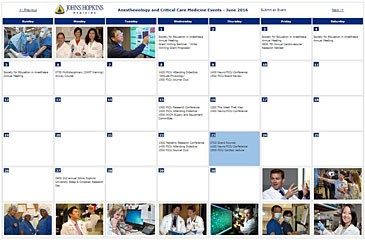 Dr. Marek Mirski is a professor of anesthesiology and critical care medicine as well as neurology and neurological surgery at the Johns Hopkins University School of Medicine. He is the inaugural recipient of the Thomas and Dorothy Tung Professorship in the Department of Anesthesiology and Critical Care Medicine.
Dr. Marek Mirski is a professor of anesthesiology and critical care medicine as well as neurology and neurological surgery at the Johns Hopkins University School of Medicine. He is the inaugural recipient of the Thomas and Dorothy Tung Professorship in the Department of Anesthesiology and Critical Care Medicine.
Dr. Mirski received his undergraduate degree in biology and chemistry from Massachusetts Institute of Technology and earned his M.D. from Washington University in St. Louis. He completed residencies in neurology and anesthesiology and critical care medicine and performed a fellowship in anesthesiology at Johns Hopkins University School of Medicine. Dr. Mirski joined the Johns Hopkins faculty in 1992.
He has been one of the leaders in the Department of Anesthesiology and Critical Care Medicine’s entry into the international patient care environment. He has been an ambassador for the Department and the Institution, caring for patients from around the world and leading missions in many countries including Bermuda, Saudi Arabia and the United Arab Emirates.
Dr. Mirski has published more than 175 peer-reviewed articles. He serves on the board of directors of the Society of Neurocritical Care and is on the editorial board of several scientific journals, including Tzu Chi Medical Journal, Contemporary Critical Care, Journal of Neurocritical Care and the Journal of Neurosurgical Anesthesiology.
He made several important discoveries in how seizure impulses travel within the brain, leading to publications in the highly regarded journals. In addition to his investigation in seizure mechanisms, he has made seminal laboratory and clinical research contributions in the fields of cerebral edema, osmotic therapy, ICU sedation and the practice of neurological critical care.
Dr. Mirski’s current laboratory research involves the investigation of the subcortical mechanisms of seizure propagation and cortical synchrony. Major efforts are directed toward the development of methodologies for seizure inhibition via site-specific subcortical electrical stimulation. The principal finding of his research—identification of synaptically linked subcortical elements important in seizure propagation—has led to FDA-sanctioned Phase III clinical trials of targeted thalamic stimulation in patients with intractable seizures. Dr. Mirski also conducts primary research in the treatment of brain edema, ICU sedation, and acute stroke.
Additional research activities include investigation of the proconvulsant action of novel alpha2-receptor agonists and pharmacologic osmolar control of elevated intracranial pressure following acute head injury. Major clinical investigations are focused on the treatment of elevated intracranial pressure, cerebral edema, ICU sedation, and clinical trials for ischemic stroke and head injury.
Professional Activities
- Editorial Boards: Journal NeuroCritical Care; Tzu Chi Medical Journal (Taiwan)
- FAER Awards Committee, American Society of Anesthesiology (2003–2005)
- Finance Secretary, Society of NeuroCritical Care (2005–2007)
- Scientific Co-Chair, Critical Care Committee, American Society of Anesthesiology (2002–present)
- Scientific Co-Chair, Epilepsy Committee, American Academy of Neurology (2003–present)
- Board Member, Society of NeuroCritical Care (2004–2007)
- American Society of Anesthesiology
- Society of Neurosurgical Anesthesia and Critical Care
- Society of Critical Care Medicine
- American Epilepsy Society
- American Academy of Neurology
- American Neurological Association
- Society of Critical Care Medicine
Selected Publications
- Bhardwaj A, Mirski MA, Ulatowski JA, eds. Handbook of Neurocritical Care. Totowa, NJ: The Human Press Inc., 2004.
- Ziai WC, Sherman DL, Zhang N, Bhardwaj A, Mirski MA. Target-specific catecholamine elevation induced by anticonvulsant thalamic deep brain stimulation. Epilepsia 46:878–88, 2005.
- Bhatti N, Mirski MA, Tatlipinar A, Koch WM, Goldenberg D. Reduction of complication rate in percutaneous dilation tracheotomy. Study of 318 consecutive patients. Otolaryngology 117:172–5, 2007.
- Mirski MA, Nyquist P, Toung TJ. Effect of hypertonic saline concentration on cerebral and visceral organ water in an uninjured rodent model. Crit Care Med 36(1):256–61, 2008.
- Hamani C, Hodaie M, Chiang J, del Campo M, Andrade DM, Sherman DL, Mirski MA, Mello LE, Lozano AM. Deep brain stimulation in the anterior thalamus: Effects of electrical stimulation on pilocarpine-induced seizures and status epilepticus. Epilepsy Res 78(2–3):117–23, 2008.
- Koenig MA, Bryan M, Lewin JJ, Mirski MA, Geocadin RG, Stevens RD. Reversal of transtentorial herniation with hypertonic saline. Neurology 70(13):1023–9, 2008.
Laboratory Members/Key Associates
Lab Manager
Kathy Kibler, BS
Faculty/Research Associates/Instructors
David Gracias, PhD
Wendy Ziai, MD
Jason Chiang, BS
Nitish Thakor, PhD
John Lewin III, PharmD, BCPS
Elizabeth Zink MS, RN, CCRN, CRNP
Shannon Ledroux, BS
Vinciya Pandian, PhDc, CRNP
Thomas Toung, MD
Clinical Coordinator
Shannon Ledroux, BS
Fellows/Students
Christos Lazaridis, MD
Athir Morad, MD
Adam Schiavi, MD
Alexander Papangelou, MD
Hans Puttgen, MD
Scott Marshall, MD
Jennifer Berkeley, MD
Dedrick Jordan, MD
Kristi Lanning, MD
Collaborations
David Gracias, PhD, JHU Department of Bioengineering, Division of Nanotechnology
Nitish Thakor, PhD, JHU Department of Biomedical Engineering
David L. Sherman, PhD, Infinite Biomedical Technologies
Honors
- Co-Winner, Neuroscience Research Prize
- Washington University/St. Louis Medical Center (1986)
- First Johns Hopkins Medicine Joint Director
- Most Influential Physician, Queen’s Medical Center, Honolulu, Hawaii (1998)
- Founding Director, Queen’s Neuroscience Institute, Honolulu, Hawaii (1996)
- Neurosciences Critical Care Division and Neuroanesthesiology (1999–present)
